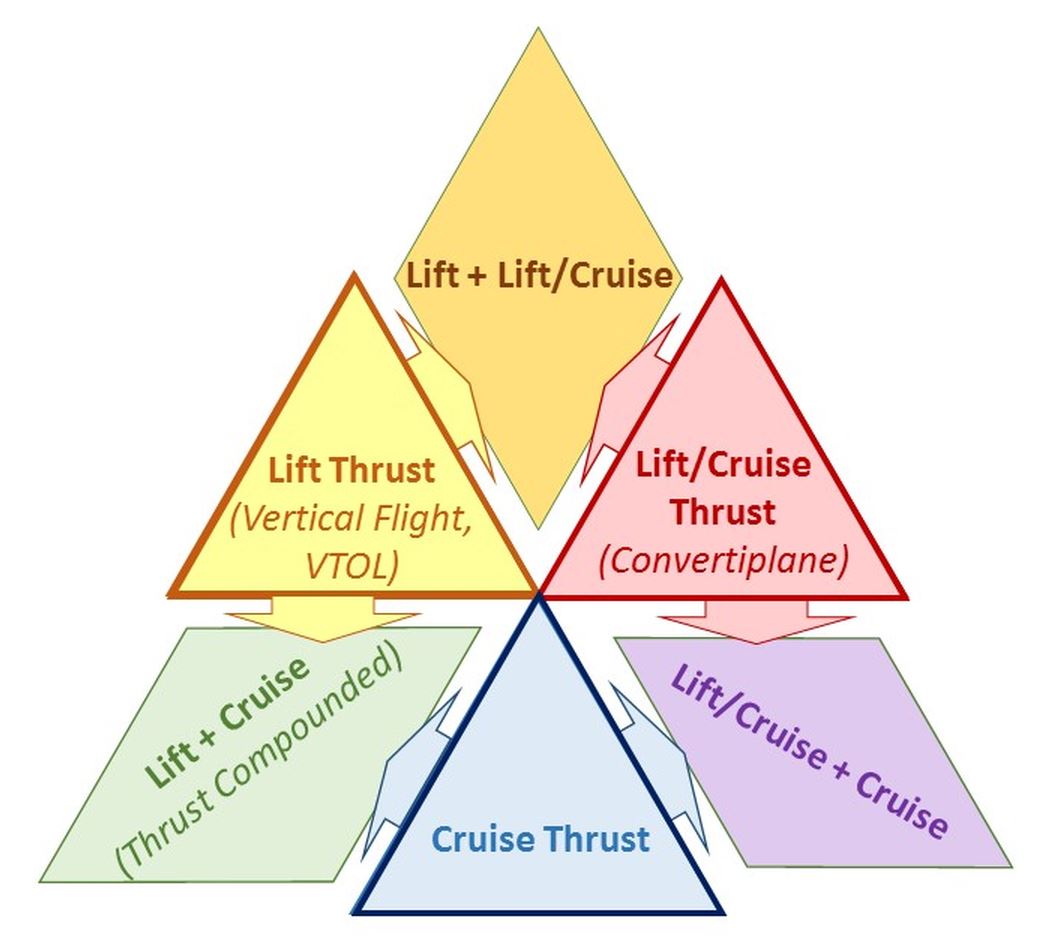EF Global VTOL
19 Jun 2023

This series addresses terminology that is misleading or erroneous, and proffers definitions to be used as canonical. Here a new overarching taxonomy for vertical-flight-capable aircraft configurations is presented. See www.eVTOL.news/terms for past columns and links to these and more extensive graphics, as well as additional reference information.
Fig. 2. Proposed V/STOL Triangle taxonomy Tier 2, differentiating between propulsor types.
The previous two installments of this series addressed past and present classification systems of vertical and/or short takeoff and landing (V/STOL) aircraft — including the NASA Campbell table and the V/STOL Wheel — and their shortcomings. Toward establishing standard, accepted terms for vertical-flight-capable aircraft configurations across the aviation academic-military-industrial complex, a robust taxonomy is proposed here (Fig. 1).
The proposed V/STOL Triangle is offered as a drop-in replacement for the V/STOL Wheel that was originally developed in the 1960s from the high-speed V/STOL aircraft that were being studied at the time. Note that the term “VTOL” refers to a subset of “V/STOL” aircraft that generally do not have fixed aerodynamic lifting surfaces for short takeoffs and/or short landings.
The first tier of the taxonomy has six categories of propulsor (thrust device) installations on the aircraft, loosely based on the classic color wheel with three primary categories — vertical lift (L), horizontal cruise (C), and combined lift and cruise (L/C) — and three combinations of these three “pure” types: L+C, L+L/C and L/C+C. Note that “C-only” aircraft (airplanes not capable of V/STOL) are also included for completeness.
The second tier of the taxonomy (Fig. 2) introduces the propulsor types in three ways. First, three different types of Lift/Cruise propulsor installations are identified: tilting, vectoring and articulating. Then, the propulsors are differentiated between “Rotors” with off-axis thrust and moment capability, and “Axial Thrust” (AT) devices without. Finally, as shown in Figure 3, the AT type is further segregated as propeller, fan, turbofan, turbojet or rocket, increasing disk loading from the center of the triangle of “Rotor(s)” toward the perimeter.
Fig. 3. Proposed V/STOL Triangle taxonomy, showing FAA categories of 116 example V/STOL aircraft in appropriate cells.
For this “color wheel,” a triangle is used to allow the many possible combinations of propulsor installation and type to be illustrated. Countless combinations of more than two propulsors are possible, but intractable. This relatively simple formulation of a complex design space was distilled through numerous iterations and will likely mature further with feedback and further debate.
This taxonomy is constructed to represent the entire design space for vertical-flight-capable aircraft, allowing characterization of any and all concepts, whether feasible or advisable (or not).
Of note, this taxonomy was developed without regard for fixed, non-rotating wings, as they could be added to virtually any propulsor approach. Similarly, the taxonomy also disregards the current regulatory categories of Rotorcraft and Powered-Lift used by the US Federal Aviation Administration. The Federal Aviation Regulations (FAR) Part 1 definitions are:
- Rotorcraft means a heavier-than-air aircraft that depends principally for its support in flight on the lift generated by one or more rotors.
- Powered-Lift means a heavier-than-air aircraft capable of vertical takeoff, vertical landing, and low-speed flight that depends principally on engine-driven lift devices or engine thrust for lift during these flight regimes and on nonrotating airfoil(s) for lift during horizontal flight.
Fig. 4. V/STOL Triangle taxonomy, showing 116 example V/STOL aircraft in appropriate cells, noting FAA category.
It was concluded in deliberations that these definitions are unclear (especially the word “principally”) and cannot cover all types of vertical lift aircraft, as validated below. An analysis of 116 vertical-flight-capable aircraft examples was conducted to test this taxonomy, and each were placed in the appropriate cell of this “V/STOL Triangle” (see www.eVTOL.news/terms). Figure 3 presents a summary of these examples on the V/STOL Triangle, showing the quantity in each cell differentiated by FAA category. As can be readily seen, the FAA definitions do not correlate with the taxonomy. This taxonomy can be a valuable input to a conversation about any interpretation or change to these categories. This will be addressed in a subsequent Vertiflite piece.
Other features not considered in taxonomy include low-speed control, powerplant/fuel, power distribution, windmilling propulsors, tail sitting or tilting wings. These are tracked for each of the examples reviewed, but do not correlate with the taxonomy.
An ongoing discussion is the treatment of propulsors without cyclic control but with provisions for edgewise flight, such as flapping. There is advocacy for these propulsors, e.g., tail rotors, as Rotors and Propellers — or a new term like “Flap Rotors” — and debate whether it should affect the taxonomy or remain just a feature. This is a good topic for community discussion.
This taxonomy intends to be sufficiently robust to cover all approaches and if found lacking, should change. Comments are invited to be sent to [email protected], and a discussion will be hosted on the Electric VTOL Community discussion board on www.vtol.org/hover.